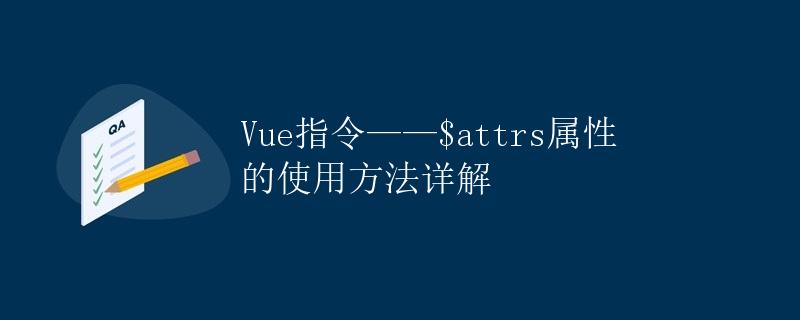Vue指令——$attrs属性的使用方法详解

1. 什么是Vue指令
Vue.js是一款用于构建用户界面的渐进式JavaScript框架。它采用了基于组件的开发模式,使得构建复杂的Web应用变得更加简单和可维护。在Vue中,指令(Directive)是一种带有特殊前缀v-的指令属性,通过特定的语法操控DOM元素。
Vue提供了很多内置的指令,如v-model、v-bind、v-if等,使得开发者可以快速地实现各种功能。除了内置指令,Vue还允许开发者自定义指令,以满足特定需求。
在本文中,我们将详细介绍Vue中的$attrs属性,它是一个特殊的指令属性,用于接收父组件传递的属性,并将这些属性绑定到子组件的根元素上。
2. $attrs属性的基本用法
attrs是Vue中的一个特殊属性,它可以用于接收父组件传递的属性。当在子组件中使用attrs时,它将会包含所有父组件传递的非Prop属性,并将这些属性绑定到子组件的根元素上。
为了更好地理解$attrs的使用方法,我们创建一个简单的示例。首先,我们在父组件中定义一个名为ParentComponent的组件,并在其中引用子组件ChildComponent。
<template>
<div>
<h2>Parent Component</h2>
<child-component></child-component>
</div>
</template>
<script>
import ChildComponent from './ChildComponent.vue';
export default {
name: 'ParentComponent',
components: {
ChildComponent,
},
};
</script>
然后,在子组件ChildComponent中使用$attrs获取父组件传递的属性,并将这些属性绑定到根元素上。
<template>
<div v-bind="attrs">
<h2>Child Component</h2>
<p>{{ message }}</p>
</div>
</template>
<script>
export default {
name: 'ChildComponent',
computed: {
message() {
return this.attrs.message || 'No message provided';
},
},
};
</script>
通过以上代码,我们可以看到,子组件的根元素使用v-bind="$attrs"将父组件传递的属性绑定到根元素上。并且,在子组件的computed属性中,我们使用this.$attrs.message来读取父组件传递的属性。如果父组件没有传递message属性,则默认显示”No message provided”。
接下来,我们在父组件中传递一些属性给子组件,并查看结果。
<template>
<div>
<h2>Parent Component</h2>
<child-component title="Hello World" message="This is a message"></child-component>
</div>
</template>
在这个示例中,我们在ChildComponent标签中传递了title和message属性。当子组件渲染时,它的根元素将继承这些属性,并正确地渲染出来。
3. $attrs的其他用法
3.1 排除属性
有时,我们希望从$attrs中排除一些属性,以避免将它们绑定到子组件的根元素上。为了实现这个需求,Vue提供了一个exclude选项。
<template>
<div v-bind="attrs" v-bind="attrs" v-bind="attrs" v-bind="attrs">
<h2>Child Component</h2>
<p>{{ message }}</p>
</div>
</template>
<script>
export default {
name: 'ChildComponent',
computed: {
message() {
return this.$attrs.message || 'No message provided';
},
},
inheritAttrs: false,
exclude: ['title'],
};
</script>
在这个示例中,我们在子组件的选项中添加了inheritAttrs: false和exclude: ['title']。inheritAttrs: false选项告诉Vue不要将$attrs中的属性绑定到子组件的根元素上,而exclude: ['title']选项告诉Vue排除属性名为”title”的属性。
3.2 合并属性
在某些情况下,我们可能想要在子组件中添加一些额外的属性,以覆盖父组件传递的属性。Vue提供了一个mergeProps选项来实现这个需求。
<template>
<div v-bind="attrs" v-bind="attrs" v-bind="attrs" v-bind="attrs">
<h2>Child Component</h2>
<p>{{ message }}</p>
</div>
</template>
<script>
export default {
name: 'ChildComponent',
computed: {
message() {
return this.$attrs.message || 'No message provided';
},
},
inheritAttrs: false,
mergeProps: {
disabled: false,
style: {
color: 'red',
},
},
};
</script>
在这个示例中,我们在子组件的选项中添加了inheritAttrs: false和mergeProps选项。inheritAttrs: false选项告诉Vue不要将$attrs中的属性绑定到子组件的根元素上,而mergeProps选项告诉Vue合并一些额外的属性。在这个示例中,我们合并了一个额外的disabled属性和一个style属性。
4. 总结
在本文中,我们详细介绍了Vue中attrs属性的用法。attrs是一个特殊的指令属性,用于接收父组件传递的非Prop属性,并将这些属性绑定到子组件的根元素上。
我们通过一个简单的示例演示了attrs的基本用法,并介绍了如何排除属性和合并属性。通过学习和理解attrs的用法,我们可以更好地使用Vue中的指令,进一步提升我们的开发效率。
 极客笔记
极客笔记